
Inland Bulgaria – Places to Visit in Bulgaria
Away from the busy tourist coastal resorts and the ski areas, there are still so many places to visit inland Bulgaria. Here are details of just a few of the towns, cities and sights we have visited over the years but more are detailed on TheTravelBug Blog.
Plovdiv
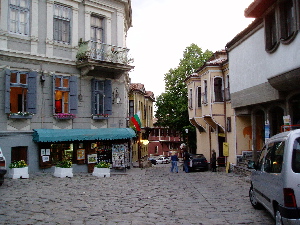
The second largest city in Bulgaria and with lovely cobbled streets and Roman ruins everywhere, it is well worth a visit. It can be a quite a chaotic place to drive around though.
Easily accessible from the main motorway and around an hour and half from Sofia. Plovdiv’s origins spam back 6000 years with Neolithic settlements making it one of the oldest cities in the world.
It has been a Thracian city, a Greek city and a Romani city. In the 14th century it fell under Ottoman rule but was liberated by the Russians in 1878, but recaptured just months later and did not return to Bulgarian rule until 1885.
It is sometimes referred to as the “City of 7 Hills” as it as developed around the syenite hills, and from a distance you can clearly see the two tallest of these in the city centre.

Every year Plovdiv hosts the International Fair and the city has hundreds of important archaeological sites, including two ancient theatres, medieval walls and towers, Ottoman mosques and bath houses and a very well preserved old quarter with houses from the National Revival period crowding over narrow cobbled streets.
Veliko Turnovo
Veliko Turnovo is in the north part of Bulgaria and is the historical capital of the Second Bulgarian Empire. It is situated on the river Yantra and the older part of the city clings to the cliff sides.
It is a very popular tourist destination with one of the main attractions being the fortress of Tsarevets, just on the edge of the city as the road winds up to Arbanassi.
It is an area very popular with British expats and there is a large population of expats in the surrounding villages.
Arbanassi was founded in the 15th century by Christians and then in the 16th century became the property of an Ottoman leader.
The local population was given many privileges in return for safe passage for the Turks and this led to the village prospering.
It has remained this way and is a place where the wealthy have their holiday homes and is now a popular destination for short breaks.
The area around Veliko Turnovo is pretty with rolling hills, lakes and many of Bulgaria’s most preserved monasteries.
Rila Monastery
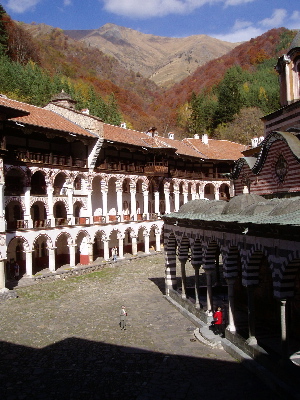
The Rila Monastery can be visited on a day trip from Sofia or is an easy drive from the Bovorets ski area. We visited in Autumn and the colours of the trees were amazing.
It is the largest and most famous of all Bulgaria’s monasteries. It was founded in the 10th century and covers an area of well over 8000sqm. You must pay for parking (which is a bit limited) but access to the main monastery is free.
The museums and certain rooms have paid access. You should make sure you visit the Ossuary down by the river as its a spooky, special place housing the bones of the monks that have lived and worked at the monastery over the years.
There are a couple of restaurants and it is quite touristy but still very very impressive.
Melnik
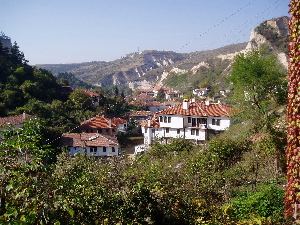
Melnik is nestled in the sandstone crags and is a short drive from Sandanski, near the border with Greece. It is known for its wine production and you can sit in a cool cave in the crag and taste the local wine.
Many of the houses have now been restored and it is a lovely place to walk around and relax. The sandstone cliffs around it have been carved into unusual shapes by the wind and rain over the years.
There is a walk over the mountains to the Rozhen Monastery but I have not personally done this.
We visited in summer of 2016 and while the town is lovely some of the best scenery is seen if you drive further on up towards the small monastery of Rozhen, where there are a couple of hotels. We did not actually go into the monastery.
Sandanski not far away is a lovely spa town with a great public park with lake. We only stopped here for a quick walk around but would like to go back for a weekend sometime.
Narrow Gauge Railway

The old narrow guage railway runs from Bansko up to Septemvri. It is a slow long journey that takes a number of hours (and you will not want to go to the toilet on the train) but the views and scenery are fantastic as the train winds it way to Velingrad and then north through valleys and hills to Septemvri.
Perperikon
The ancient ruins of the Fortress of Perperikon are located around 20 km north-east of the town of Kardjali in Southern Bulgaria in the Rhodopes Mountains.
The fortress was begun in the iron age and was then reconstructed and building continued through the middle ages.
It is perched on top of a small hill with spectacular views across the surrounding country side. To approach the ruins you need to go up some ancient and huge carved stone steps through a corridor of stone.
This brings you out on top of the hill where you are free to wander around the fortress, church and ruins. This is one of the most amazing places I have been to. I have visited three times now.
There is a video on the youtube channel that is worth viewing and I have written an article on it here and there is a blog post here.
Velingrad
The spa town of Velingrad is well worth a stop off if you have time. It has a lovely centre with a fountain and pedestrianised area.
There are also mineral spa baths and it is a popular destination with Bulgarians for a summer break. It is quite a few years since I have been there now though.
Lake Batak

This was one of the areas mooted for development years ago. There was talk of a small ski area and all sorts. None of this materialised but it is a lovely place. We recently visited here again on the way to visit a friend near Samokov.
There are various camp sites around the edge of the lake and a few large houses, but there were no signs of any real development. Its popular for water sports and fishing.
Devin
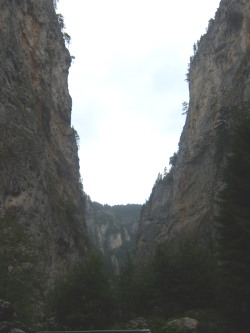
Several years ago I stayed in Devin for a few nights and explored the sites there. The drive over the Rhodopes is very scenic if a little hair-raising at times.
Around an hour from Devin, just before you descend into the valley, there is a small lake with a few privately owned, floating houses.
Devin itself is not the most attractive town but is nestled in the heart of the mountains and so for walking, horse riding and relaxing, it is a great place. It is famed for its mineral spa water but to be honest we have been to better mineral spa towns in Bulgaria.
Close by, are several famous caves including the ‘Devil’s Throat’, a massive cavern where a huge waterfall disappears into the earth and the Yagodina cave.
The Trigrad gorge is accessed by a winding road through the valley. Sheer cliffs wall you in on either side as you follow the river Trigradska up.
For more details read about our trip to the caves and gorge here.
Rhodopes – Around Smoylan & Pamporovo
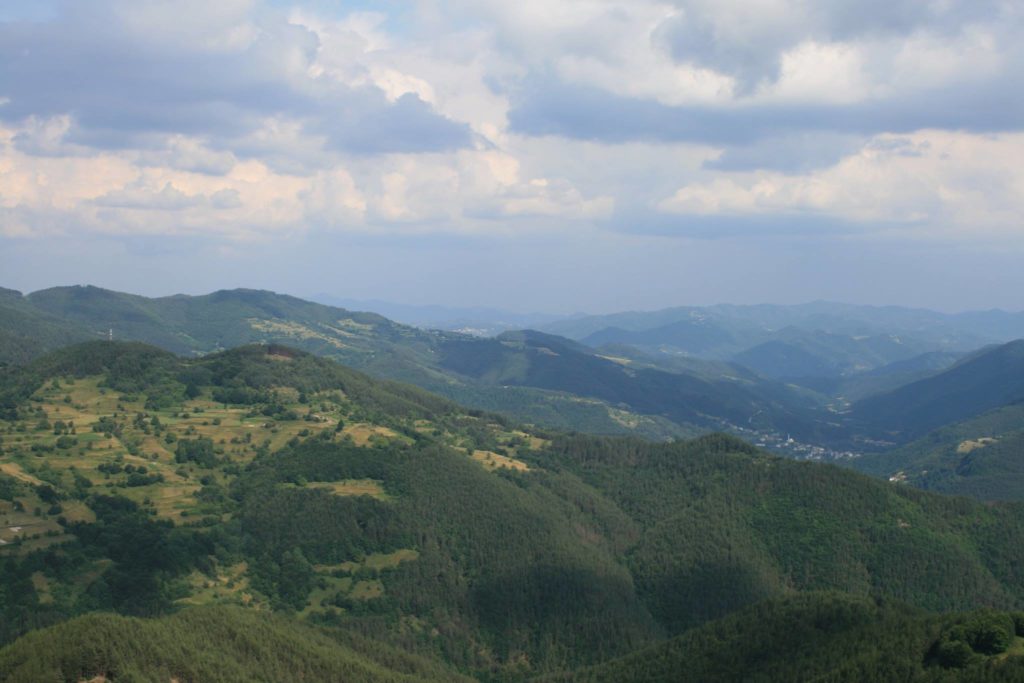
We have good friends that live close to Smoylan so spend some time here each year. The scenery in the mountains is absolutely stunning and if you are prepared to drive around bit and explore there is loads to see and do. Smoylan town has a pleasant pedestrianised centre and some lovely traditional buildings in the old part.
A short drive west of Pamporovo brings you to Shiroka Laka village, famous for the traditional Rhodope building style and also its folk music, played on a type of bagpipe. Its a nice place to wander around, although was rather wet when we visited!
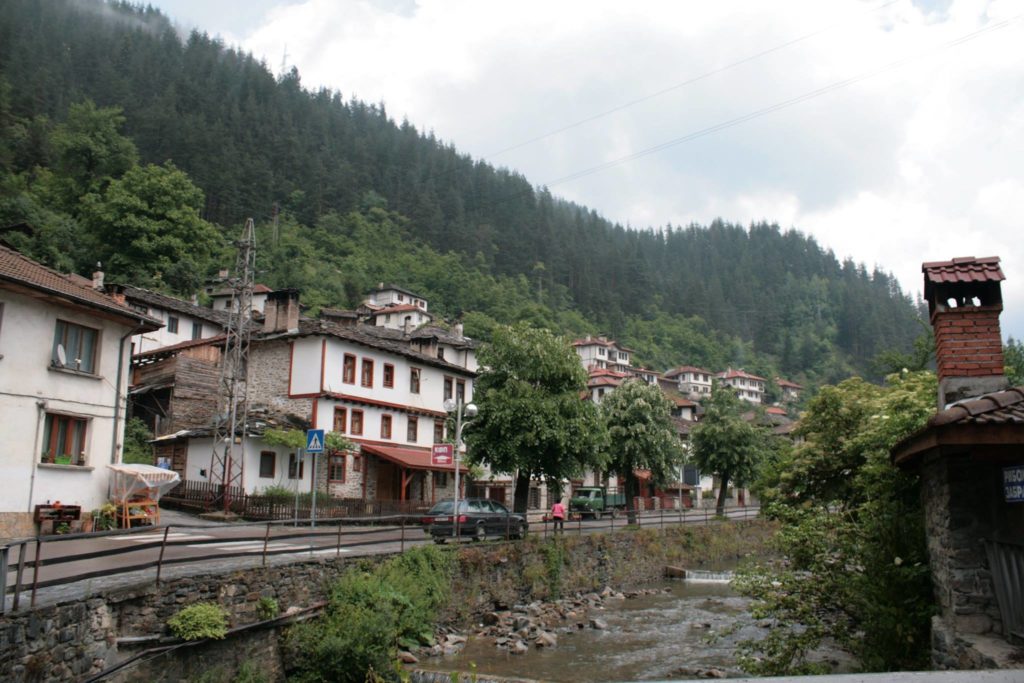
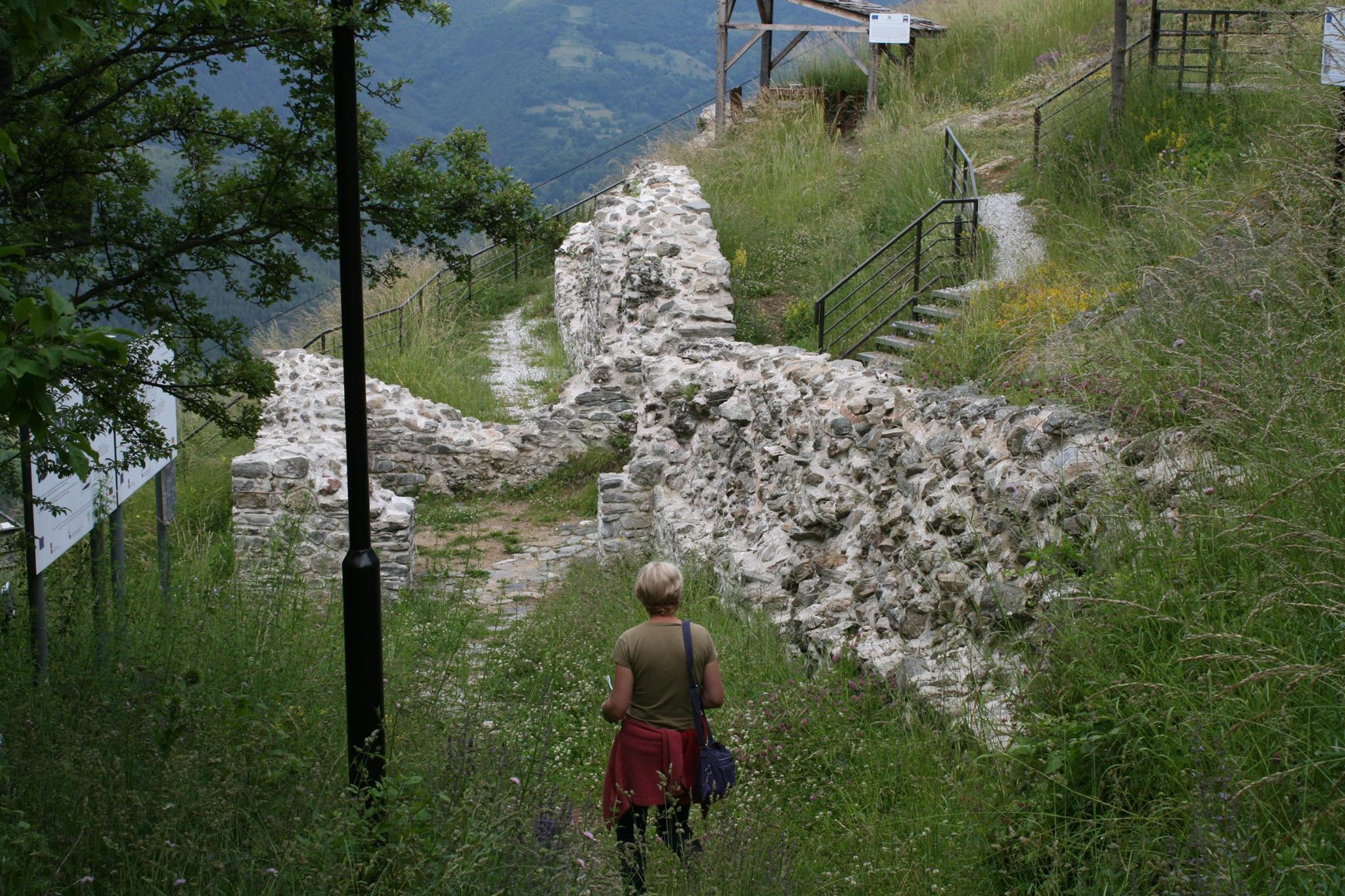
An easy drive east of Smoylan and you see the turn off for Momchil Fortress. You drive up a winding road through the village of Gradat and near the far end of the village take a sharp left along a newly tarmac road for a few kilometres.
You come to a small car park and a kiosk at the bottom of the trail up to the fortress. We arrived at around 4pm and it was 3 levs each to get in, with a map and small guide pamphlet.
You could also hire a guide to do tour with you (I think). It is a fairly steep climb up a track to the fortress, although there wooden pergola’s on the way with benches where you can take a rest.
The actual fortress is quite small and takes only a short time to explore, but the views are amazing with 360 degree vistas all around – across to Pamporovo, down to Smoylan and over towards Ruzodem.
We also took a drive through the village of Smilyan, following the river Arda along. We were looking for the fortress near Mogilitsa, but it was on the top of a rocky outcrop and it was one heck of a climb up and there just seemed to be the outer walls left.
There are also the caves at Uhlovitsa, as well as many other cave systems to explore in the area, but many require a serious hike to get there.
Madara Horseman & Fortress near Shumen
Further inland, close to Shumen, about an hour’s drive west of Varna, take the signs for Madara and drive through the village.
After a few minutes you’ll come to a couple of snack bars and a souvenir shop. There is a small car park and opposite the cash desk to pay the 4 levs per person fee to enter.
At first we were not sure whether to bother paying as the guide book said the bas-relief (carving) of the man on a horse with dog, killing a lion, from the eighth century of earlier, was badly eroded and hard to make out.
But we decided as we had made the effort to drive there, we would pay and go in. You go up a long flight of stone steps and at the top you see the carving in the cliff face.
I was expecting something far larger but it is still quite a sight, given how long ago it was done.
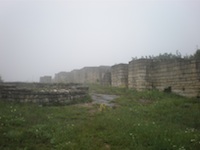
There is plenty more to see in this area. Heading down from ‘Madara Horseman’ you can take a right and after around 500 metres you find yourself climbing rough cut stone steps in the cliff face.
The going is hard work and for anyone with mobility problems or who is not fairly active, I would not advice going up. There must be a thousand steps or so, some very steep with just a small handrail to hold on to.
Health and safety are never high on the agenda in Bulgaria and here especially. At the top you follow a track (there are no sign posts) and eventually come to the ruins of an old fortress.
Be careful because if you walk along the wall to the left, it suddenly ends at the cliff edge with no warning (the danger sign as fallen down the cliff) and no fencing.
When going back from the fortress to the steps down, becareful to get the right track as there are no markers and we ended up following a more worn track for a while, before realising we were going the wrong way.
Once you have made your way down to the bottom of the cliff again (becareful as its steep and slippery if wet) go back past the bas-relief and carry on to the left towards the caves. The sheer size of one of the ‘caves’ is impressive and there are some ruins at the base.
The carving and ruins are well worth a stop off if you are travelling along this route, but there is little else to see in the area (except maybe the Pliska ruins and the Preslav ruins – neither well preserved) and the countryside is pretty non-descript and boring.
Rock Monasteries near Ruse and Chevren Fortress
About an hour or so north of Veliko Turnovo there is Chevren fortress, a medieval fortified village situated on the top of a rockery outcrop.
The location is stunning and its definitely worth a visit. You can see photos and read more about it on the news page.
Just up the road are the rock churches of Ivanovo. The rock monastery of “St. Archangel Michael” is situated just 22 km from Ruse and in the Natural Park “Rusenski Lom”.
There is good access on an asphalt road to a small car park, from where a path provides access to the chapels built into the caves. The monastery was founded in the 1220’s and has beautiful well preserved wall and ceiling paintings inside.
Around 10km further on towards Ruse is the only working rock monastery in Bulgaria – “St. Dimitrius Basarbovski”. There is a lovely yard and garden at the bottom of the rock cliff and then narrow steep stone steps take you up to the caves, where there is a church, ossuary room and the small hollowed out cave where the monk St. Dimitrius is supposed to have slept.
Lovech

Lovech is in north Bulgaria and has a pleasant old town to wander around, although the rest of the town does not hold much appeal. Lovech is famous for its covered wooden bridge. At the top of the hill above the town there is the ruins of the old fortress.
The old town has some lovely old houses and cobbled streets with some lovely traditional restaurants.
If you are in the area, its worth a stop off for a couple of hours.
Troyan (Monastery)
Troyan Monastery is the third largest in Bulgaria, and while not as imposing as Rila Monastery, it is a lovely place, not as touristy and you can just wander around.
There is a lovely court yard and garden, the central church and bell tower and its free entry, as are most Monasteries in Bulgaria.
It is where revolutionary Vasil Nevski hid for a while and also home of the “Three Handed Virgin Mary” – an icon with supposed miraculous powers.
At the far end of the church, in the crypt underneath is a small room with the skulls and bones of monks.
Troyan town itself was very depressing and had nothing to merit a visit.
